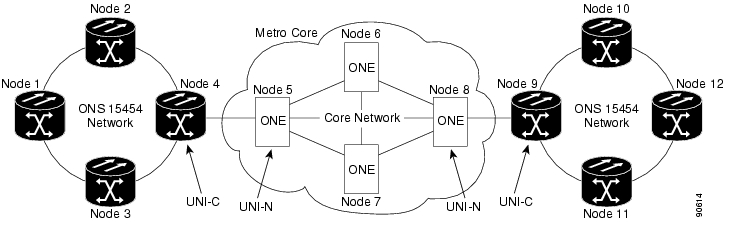|
|

This chapter provides an overview of the unified control plane (UCP) and the user-network interface (UNI) implementations, supported by the ONS 15454 SONET and SDH systems. Cisco Transport Controller (CTC) releases 3.4 and later support UCP.
This chapter contains the following sections:
UCP is a software feature released for Cisco ONS 15454 SONET and SDH Releases 3.4 and later. It provides a service architecture that can manage and provision network elements (NEs) using a single management layer. For example, UCP allows a user to perform "A to Z" provisioning outside of an ONS 15454 section data communications channel (SDCC)-connected network without a higher-layer management system to communicate between subnetworks. The network infrastructure can include assorted NEs such as routers, Layer 2 (L2) and Layer 3 (L3) switches, SONET and SDH optical products, optical cross-connects, and wavelength routers.
UCP comprises two major interface types, a user-network interface (UNI) and a network-network interface (NNI). Both UNI and NNI are optical interfaces. UNI conforms to the Optical Internetworking Forum (OIF) UNI 1.0 standards. It provides data client services, rapid provisioning of SONET and SDH circuits through an optical internetwork, and signaling between a client device and a transport network element. NNI exchanges signals and routing data between NEs in a network. The difference between UNI and NNI is that UNI does not support the exchange of routing information (such as topology data) across the interface. The ONS 15454 SONET and SDH systems do not support NNI configuration.
This section describes the client and network roles, communication between adjacent nodes, port addressing requirements, and inter-domain circuits in a UNI implementation. The Cisco Transport Controller (CTC) is the network management tool used for UNI provisioning. All circuit capabilities supported in the ONS 15454 SONET and SDH Release 3.4 and later are available for UCP circuit provisioning.
UNI is divided into client (UNI-C) and network (UNI-N) roles. A UNI-C network element requests and accepts circuit provisioning information. A UNI-N network element is the node adjacent to the UNI-C node and accepts and transports circuit provisioning information across the core network. For UNI circuit provisioning, the network must meet the following requirements:
The ONS 15454 SONET and SDH Releases 3.4 and 4.0 support UNI-C provisioning.
Figure 1-1 shows the position of the ONS 15454 (either SONET or SDH) in a customer network environment. In this example, Node 4 can request Node 9 as a circuit destination. Node 5 handles the signal and establishes a circuit through the metro core. The ONS 15454 networks on either side of the core network are aware only that they are connected to the core at Node 5 and Node 8, respectively.
 |
Note Nodes 5 and 8 must support the UNI-N feature for UNI-C on the ONS 15454 to work. |

Adjacent UNI-C and UNI-N NEs, called "neighbors," communicate over a control channel. A control channel is a logical channel between two neighbors that have one or more links capable of carrying data. Link management protocol (LMP) establishes and maintains control channel connectivity between neighbors. LMP also enables neighbor discovery, which allows neighbors to identify connected devices; obtain UNI connectivity information; and identify and verify port-level connections, network-level addresses, and corresponding operational states for every link.
Each control channel has a unique 16-bit identification number, called a CCID. Each end of a control channel requires a local IP version 4 (IPv4) or IP version 6 (IPv6) control channel (IPCC) address. By default, this address is the internal address of each neighbor, but can be a different address.
Control channels can be in-fiber/in-band (IF/IB), which means that the control channel uses the same physical link as the data link that controls it or out-of-fiber/out-of-band (OF/OB), which means that the control channel uses a different physical path than the data links it controls. IF/IB, also called SDCC IPCC, is transported over the embedded SONET/SDH SDCC bytes between the client and the network interface. OF/OB, also called routed IPCC, is transported over the 10/100T Ethernet interface.
Each UNI-C NE must have a port configured for UCP implementation. This port is called an interface or datalink. Each port in a UNI-C connection must have an identifier called a transport network address (TNA). A TNA can be in IPv4, IPv6, or network service access point (NSAP) format.
An inter-domain circuit (IDC) is an end-to-end circuit that can contain both UCP-signaled and non-signaled circuits. A UCP-signaled circuit is a circuit routed across the core network; it originates at a UNI-C interface in one network and terminates at another UNI-C interface in another network.
Resource ReSerVation Protocol (RSVP) is protocol originally designed to request specific qualities of service (QoS) from the network for particular application data streams or flows. RSVP can now provide a signal for SONET/SDH circuits. The control channel transports these RSVP messages, which carry source and destination addresses and required circuit attributes, such as bandwidth, framing type (SONET or SDH), connection diversity, and service level.
A non-signaled circuit is a circuit within a subnetwork; it is not routed across the core network.
The ONS 15454 SONET and SDH Release 3.4 and 4.0 UNI implementation supports signaling over optical interfaces. The supported circuits sizes for the UNI-C interface are STS-1, STS-3c/STM-1, STS-6c, STS-9c, STS-12c/STM-4, STS-24c, STS-48c/STM-16, STS-192c/STM-64.
Figure 1-2 shows an example of an inter-domain circuit. You can create inter-domain circuits on the CTC Circuits tab in network view.
![]()
![]()
![]()
![]()
![]()
![]()
![]()
![]()
Posted: Tue May 13 19:03:10 PDT 2003
All contents are Copyright © 1992--2003 Cisco Systems, Inc. All rights reserved.
Important Notices and Privacy Statement.